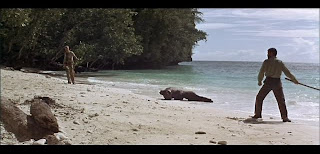
Grover Cleveland is well known as the only Chief Executive to serve non-consecutive terms, which he did as the 22nd president, from 1885 to 1889, and the 24th president, from 1893 to 1897.
Now, he
’s got company...
In the first real blockbuster of 2013,
Olympus Has Fallen, Morgan Freeman portrays Speaker of the House Allen Trumbull. When President Asher is taken hostage by North Korean terrorists and held in the bunker of the White House, Trumbull assumes the role of Acting President of the United States.*
* I do not know what happened to the Vice President that he was stepped over in the chain of succession, because I have not seen the film—although I hear the popcorn is subpar.
Freeman previously portrayed President Tom Beck in 1998
’s
Deep Impact.
Okay, as implied by the Twenty-fifth Amendment of the U.S. Constitution and set in precedence several times since its ratification, Morgan Freeman’s term as Acting President is not recognized as a formal,
“numbered
” presidency—as were, of course, Grover Cleveland’s non-consecutive terms—but as far as the martini-clouded judgment of Mount Drinkmore is concerned, it’s legit enough for this post.
Thus having irrefutably—straight up with one olive—established Morgan Freeman’s non-consecutive presidencies...
Sure, thanks to his presidencies being fictitious, Morgan Freeman never got bogged down in such cinematically mundane crises as tariff issues, economic panics, and thorny questions of colonial annexation—as did Grover Cleveland—but Freeman still was under tremendous pressure to remember his lines, do promotional press junkets for the movie, and keep himself from becoming obese and bushily mustachioed.
Yet Morgan Freeman
’s remarkable, on-screen political achievements don
’t end there: As Speaker of the House Trumbull fifteen years after he was President Beck, Freeman joins John Quincy Adams as the only former presidents to serve as members of the House of Representatives, which Quincy Adams did from 1831 to 1848.
†
† A further link between the two men is that Morgan Freeman portrayed the freed slave, Theodore Joadson, in the film Amistad, which, in part, retells John Quincy Adams’ successful 1841 defense of the “mutinous” slaves aboard the Amistad. (Even further, Morgan Freeman’s surname, itself, echoes Quincy Adams’ work as an abolitionist.)
Yes, Morgan Freeman has proved himself a titan of celluloid American politics. And still at the top of his game as a busy Hollywood actor, the 76-year-old Freeman has time and opportunity to become the only former president to serve in
both houses of Congress, or perhaps even serve an unprecedented
third non-consecutive term as Commander-in-Chief
—a landmark achievement of which Freeman
’s agent will hopefully possess enough savvy to be aware.
(Image of Deep Impact copyright DreamWorks Pictures; image of Olympus Has Fallen copyright Millennium Films.)
 True, Nicholson ad-libbed this legendary line, but once such
a great idea was out of the bag, there’s no reason that Stanley Kubrick—notorious
in Hollywood for shooting excessive takes—couldn’t have had an intern run out
to a local linen store, order a replica Tonight
Show curtain, and instructed Nicholson to redo the scene with the proper
prop.
True, Nicholson ad-libbed this legendary line, but once such
a great idea was out of the bag, there’s no reason that Stanley Kubrick—notorious
in Hollywood for shooting excessive takes—couldn’t have had an intern run out
to a local linen store, order a replica Tonight
Show curtain, and instructed Nicholson to redo the scene with the proper
prop. 












































